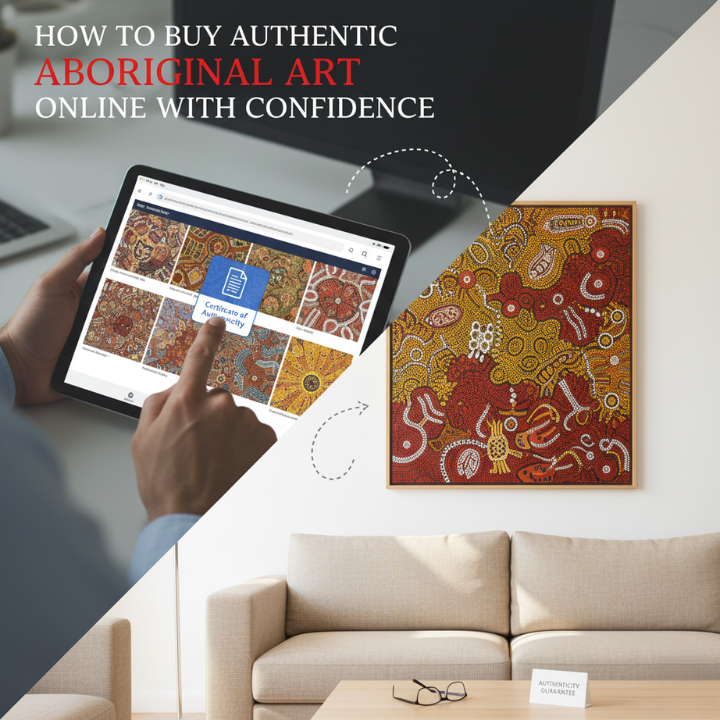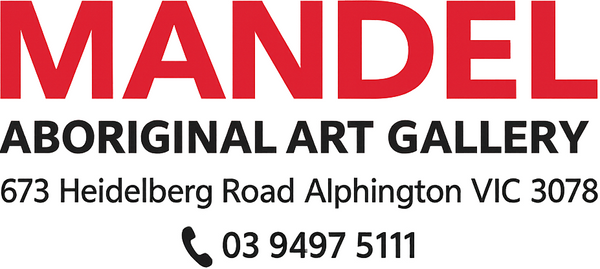
How to Buy Authentic Aboriginal Art Online with Confidence
Share
Online purchase of Aboriginal art can be an adventurous experience into one of the world's oldest and most deeply rooted artistic traditions. Nonetheless, with the emergence of online auctions, it is essential to understand how to evaluate authentic works accompanied by certificates of authenticity. This guide will assist beginners in making ethical and secure purchases so that you can get a beautiful piece of art and respect and support Indigenous culture.
Why Buy Aboriginal Art Online?
The digital era has revolutionised the art world, and now more than ever before, one can easily purchase beautiful pieces anywhere in the world. Purchasing Aboriginal art over the internet has great benefits to both experienced and novice collectors. It offers unprecedented access, enabling you to get in touch with artists and established galleries around Australia without necessarily having to travel.
The internet also offers a huge diversity in Indigenous Australian art, with iconic dot paintings to ancient bark canvases, all of which are accessible in a great diversity of styles, sizes and price levels. This is an increasing trend in selling Aboriginal art online, and through this, it has allowed collectors around the world to experience and contribute to this cultural heritage.
Understanding Certificates of Authenticity in Aboriginal Art
One important document that is essential in buying Aboriginal art is a Certificate of Authenticity (COA). It serves as an assurance of the authenticity and moral origin of the art. An effective COA must contain the following important information:
- The artist's name and community
- The title of the artwork and its medium
- A photograph of the piece
- The story or meaning behind the artwork
- Details of the community art centre or gallery that sourced the piece
This is a document that safeguards the artist and the buyer. To the buyer, it gives them the assurance of the purchase and acts as a confirmation of its value and origin. To the artist, it guarantees them that they are getting what they deserve and that they are no longer being used or counterfeited. Buying from an Aboriginal Art Gallery without a certificate of authenticity can be very risky, as the artwork may be fake or sourced unethically, potentially supporting exploitative practices.
Where to Buy Authentic Aboriginal Art Online
To ensure your purchase is both authentic and ethical, it’s vital to buy from a trusted source.
Reputable Aboriginal Art Galleries Online
Long-standing relationships with artists and their communities have been established by established galleries, such as Mandel Aboriginal Art Gallery. We authenticate each work and give the required documentation.
Community Art Centres & Artist Cooperatives
These centres are the core of the production of Aboriginal art. When people purchase through their online stores, they are purchasing directly in support of Indigenous communities and artists are compensated appropriately with profits repurposed into local initiatives.
Trusted Online Marketplaces
When using a third-party marketplace, seek out sites that have stringent processes of vetting sellers, have clear policies regarding authenticity, and demand certificates of authenticity on all of the listed Aboriginal art.
How to Verify an Ethical Indigenous Art Purchase
Making an ethical purchase goes beyond simply getting a good deal. Take the time to:
- Research the artist's background and community: Understanding their heritage and artistic practice adds to the value of your piece.
- Check the provenance and gallery reputation : A reputable gallery will be transparent about where its art comes from.
- Ensure fair trade practices: Your purchase should contribute positively to the artist and their community, with no exploitation in the process.
Popular Aboriginal Art Styles Available Online
Being familiar with the prevalent styles will enable novices to make a wise decision. Although the number of Aboriginal art styles is many, some of the most popular styles include:
- Dot Painting (Central and Western Desert): A type of iconic style that is created to hide the sacred narratives and yet project the nature of the ancestral Dreaming.
- Bark Painting (Arnhem Land): An ancient technique using natural ochres on bark, often depicting creation stories and ancestral beings.
- X-ray Style (Arnhem Land): A distinct form of cultural storytelling where the internal organs and skeletal structures of animals and humans are shown.
- Wandjina Art (Kimberley): Depictions of powerful ancestral beings, considered cloud and rain spirits.
- Contemporary Aboriginal Art: Pieces of art, which combine the traditional motives and stories with the modern medium and the ways of artistic expression.
Tips for First-Time Buyers of Aboriginal Art Online
- Set a budget before you start browsing to help narrow your search.
- Prioritise certificates and provenance above all else. This is your primary guarantee of authenticity.
- Buy from galleries or centres with transparent practices.
- Choose a piece you connect with personally. An artwork is a reflection of your own aesthetic and values.
Preserving and Displaying Your Aboriginal Artwork
- Proper care is essential to protect your investment and preserve the artwork's integrity.
- Handling and Storage. Handle canvases by their edges and store them flat or rolled with care, depending on the medium.
- Protection. Protect your art from direct sunlight, which can fade colours, and from extreme temperature or humidity changes.
- Framing. Consider professional framing with UV-protective glass to safeguard against light and dust.
Common Mistakes When Buying Aboriginal Art Online
Avoid these pitfalls to ensure a successful and satisfying purchase:
- Relying only on images: The beauty of a piece in a photo might not tell the full story. Always check for a certificate of authenticity and provenance.
- Buying from unknown sellers: A lack of history, reviews, or transparent information is a red flag.
- Ignoring ethical sourcing: Unusually low prices can sometimes indicate that the artist was not paid fairly.
Buying Aboriginal Art Online with Respect
Aboriginal art is a wonderful example of great cultural heritage that is easily accessible by buying it on the Internet. Nonetheless, this ease of access comes with a price of researching and buying morally. By insisting on a certified original Aboriginal art and purchasing from credible sources, you are not only purchasing a wonderful artwork, but you are also supporting the Indigenous artists and contributing to the existing culture that will be handed over to later generations.
Explore Authentic Aboriginal Art with Mandel Aboriginal Art Gallery
Mandel Aboriginal art gallery sells a selection of authentic indigenous Australian art, where each work will have a certificate of authenticity. We collaborate directly with artists and community art centres to make no unethical purchases or meanings. We encourage you to explore our online gallery, learn the history of the artworks, and locate a work that resonates with you. Contact us for a detailed look at Aboriginal Art from all over Australia.
FAQ – Buying Aboriginal Art Online
Q: How do I know if Aboriginal art online is authentic?
A: Look for a reputable gallery or community art centre that provides a Certificate of Authenticity for every piece.
Q: Why is a certificate of authenticity important?
A: It's your guarantee that the artwork is genuine, ethically sourced, and provides a documented history of the piece and its artist.
Q: Where can I buy ethical Indigenous art online?
A: Buy from established galleries with a history of ethical practices, or directly from community art centres and artist cooperatives.
Q: Can I buy Aboriginal art directly from artists?
A: It is often difficult to buy directly from individual artists. The most ethical and reliable way to ensure a fair price for the artist and a guaranteed authentic piece for you is to purchase from a community art centre or a reputable gallery that works directly with artists.
Q: Is buying Aboriginal art online a good investment?
A: While some pieces appreciate in value, the primary focus for a collector should be the personal and cultural connection to the art. The ethical and authentic nature of the piece is its truest value.

